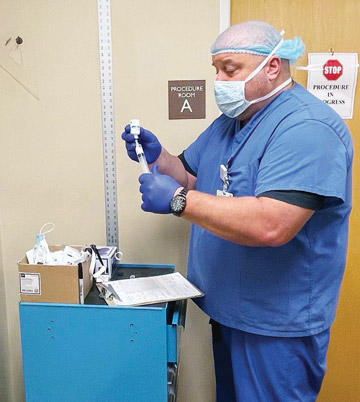The Oregon Clinic Gastroenterology East at Gateway in Portland ?shut down in March for nearly two months when the pandemic's initial wave hit the west coast hard. The center's physicians recently worked through the backlog of patients who had their colonoscopy screenings postponed during the nationwide shutdown of elective procedures, and now the facility is chipping away at a waitlist of new patients. The overwhelming demand for colonoscopies is a good problem to have, but it makes for long and busy days.
On a typical morning, the first patient arrives at 6:30 a.m., the first case begins a half-hour later and the last screening typically starts around 4:30 p.m. The nine-and-a-half hours in between are a bustle of activity as patients are moved through procedure rooms and endoscopes are pushed through the reprocessing area. Each physician in the facility performs 10 to 14 procedures, which translates into 40 to 50 colonoscopies per day. Four of the facility's six procedure rooms are up and running, with a fifth expected to reopen soon.
All patients are required to be tested for COVID-19 within 72 hours of their scheduled procedures —members of the facility's scheduling staff contact patients before procedures to inform them of the closest testing site. Patients who test negative are asked to self-quarantine at home until their procedures. Most patients arrive with completed test results, but the facility has reserved a single procedure room for cases involving the small percentage of patients whose results were not returned in time. Staff clean the room thoroughly after procedures and wait 16 minutes for a complete air exchange to occur before bringing in the next patient.
It's been a lot for the staff to manage, especially with new requirements such as social distancing —chairs in the facility's waiting area are spaced to ensure patients remain six feet apart —and the more intensive surface cleaning that's needed to safely care for patients during the pandemic. These factors have helped them maintain overall efficiencies as the center continues to get back up to speed:
- Standardized turnovers. Two designated staff members float throughout the day to turn over procedure rooms. "One floater wipes down the endoscope tower and starts cleaning the room from right to left," says Wendy Wellott, RN, an endoscopy nurse ?at the facility. "The other starts working on the left side of the room, and they meet in the middle."
Endoscope reprocessing techs who work procedures wipe down the exterior of scopes to prevent gross debris from drying on the surfaces and flush their internal channels with enzymatic cleaner before transporting the instruments to the decontamination area. The scope tech returns to the procedure room with a clean scope, and the floater sets it up for the next case while the scope tech inputs the next patient's information into the bedside computer.
"Storage drawers placed conveniently in procedure rooms house needed supplies, including packs containing suction tubing and small sponges used during the bedside cleanings of scopes," says Ms. Wellott. "The tech who works procedures sets up supplies for the next case."
The coordinated efforts result in rooms being turned over in about six minutes.
- Streamlined scope care. Three techs work in the center's decontamination room: Two on the dirty side to manually clean scopes and run them through an automatic endoscope reprocessor (AER); one on the clean side to make sure reprocessed scopes are ready for the next case and delivered to a procedure room. The facility has four automatic endoscope reprocessors (AERs), each with the capacity to high-level disinfect two scopes in independently operated bays. Techs use the units' barcode scanning technology to automatically document scope model numbers, the case scopes were used in, and the disinfecting chemicals and detergents used during reprocessing cycles.
.svg?sfvrsn=be606e78_3)

.svg?sfvrsn=56b2f850_5)